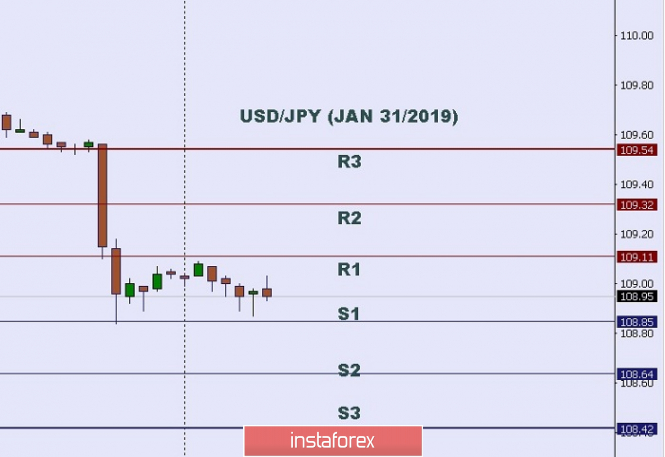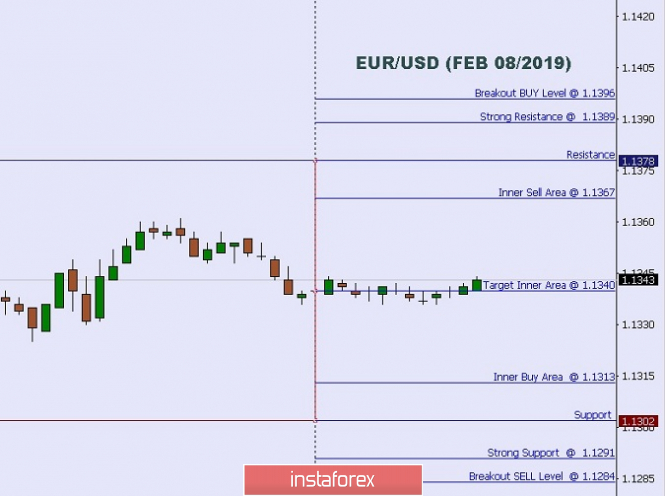InstaForex Gertrude
Active member
GBP/USD: do not succumb to the illusions of growth
The pound/dollar pair is now extremely unreliable in the context of any forecasts – and in the short term, and even more so in the long term. The general weakness of the US currency can create the illusion of the northern trend of GBP/USD, but in this case it is absolutely impossible to focus on the dynamics of the dollar. "Cable "for two and a half years is completely subject to Brexit, so the vector of price movement here depends only on the fate of the "divorce process".
However, sometimes emotional news related to the prospects of the Federal Reserve's monetary policy still drowns out Brexit. One of those rare occasions happened yesterday. The resonant statement of the head of the Federal Reserve of Atlanta that the regulator can hypothetically reduce the interest rate coincided with the failure of the British parliament to vote for Theresa May's government. The GBP/USD pair remained in its positions (showing even the northern dynamics) only at the expense of the dollar that had sharply fallen throughout the market.
Although in reality there are no reasons for optimism among bulls of the pair, and there was no. Although in reality there are no reasons for optimism among bulls of the pair, and there is no.
On the one hand, the amendments adopted yesterday by British MPs do not entail any serious consequences - at least for today. Members of the House of Commons have adopted amendments to the tax law, thereby limiting the powers of the Cabinet of Ministers in this area in the event of the development of a "hard" Brexit scenario. Now the Ministry of Finance will not be able to change the amount of taxes (thus offsetting the negative effect of "hard" Brexit), if this step is not approved by the deputies. According to legislators, this rule will prevent the country's chaotic exit from the EU: "Now Theresa May must by all means reach a compromise solution with the European Union and the British Parliament," said Labour leader Jeremy Corbyn.
The logic of this law is to "force negotiations": as many politicians believe, Theresa May has largely conceded to Brussels, and now "frightens" the Parliament by the lack of any alternative to the agreement reached. The above norm, in the opinion of the deputies, will incline the prime minister to additional negotiations with the EU.
British MPs adopted another rule and is very significant of character. Parliament ordered the government to prepare a new Brexit plan if the members of the House of Commons do not vote on January 15 for the proposed draft deal. Moreover, ministers are obliged to present a "plan B" within three days after the failed vote. 308 of the 618 deputies of the lower house of Parliament voted in favour of the proposal, while 297 opposed the idea.
It is not even the essence of the adopted bills that is important here (although their content also speaks volumes) - yesterday's voting showed a preliminary political alignment in the Parliament. And apparently, it is clearly not in favor of "soft" Brexit. The results of the vote suggest that the majority of deputies in the House of Commons are opposed to leaving the EU without an agreement – May's opponents are not only among Labour and other opposition parties, but also among "their" conservatives.
Thus, the British prime minister's "saving strategy" seems to be a fiasco. Let me remind you that the local press this week discussed a possible scenario in which the Parliament approves the deal, but only if Brussels provides additional guarantees regarding the duration of the special regime on the Northern Ireland border. As you can see, the Parliament decided to go its own way, playing ahead. In addition, representatives of the European side also hurried to assure their British colleagues that they will no longer discuss the terms of the deal – under any conditions.
What are the options then? According to the majority of experts, there are not so many of them, or to be more precise, only two: either the prime minister will postpone the vote again, as it was in December, or she will postpone the country's exit from the EU for an indefinite period, using the decision of the European Court of Justice, which at the end of last year clarified the provisions of the 50th article of the Treaty of Lisbon. Both options are negative for the British currency, despite the fact that they save from the "hard" Brexit. The market is quite exhausted by the two-year period of uncertainty, so the prolongation of this regime will be bad news for GBP/USD bulls.
That is why the northern dynamics of the pair now looks unreliable and unconvincing. Long positions on the pair are too risky, especially on the eve of January 15, when a key vote in the British Parliament is to be held. If Theresa May takes one of the two decisions listed above at the weekend, the pound may collapse on Monday for several figures, as it was in mid-December. It will be possible to speak about the confident growth of the "cable" only when the "soft" Brexit becomes a reality – that is, when it receives the approval of the British parliamentarians.
Analysis are provided by InstaForex
The pound/dollar pair is now extremely unreliable in the context of any forecasts – and in the short term, and even more so in the long term. The general weakness of the US currency can create the illusion of the northern trend of GBP/USD, but in this case it is absolutely impossible to focus on the dynamics of the dollar. "Cable "for two and a half years is completely subject to Brexit, so the vector of price movement here depends only on the fate of the "divorce process".
However, sometimes emotional news related to the prospects of the Federal Reserve's monetary policy still drowns out Brexit. One of those rare occasions happened yesterday. The resonant statement of the head of the Federal Reserve of Atlanta that the regulator can hypothetically reduce the interest rate coincided with the failure of the British parliament to vote for Theresa May's government. The GBP/USD pair remained in its positions (showing even the northern dynamics) only at the expense of the dollar that had sharply fallen throughout the market.
Although in reality there are no reasons for optimism among bulls of the pair, and there was no. Although in reality there are no reasons for optimism among bulls of the pair, and there is no.
On the one hand, the amendments adopted yesterday by British MPs do not entail any serious consequences - at least for today. Members of the House of Commons have adopted amendments to the tax law, thereby limiting the powers of the Cabinet of Ministers in this area in the event of the development of a "hard" Brexit scenario. Now the Ministry of Finance will not be able to change the amount of taxes (thus offsetting the negative effect of "hard" Brexit), if this step is not approved by the deputies. According to legislators, this rule will prevent the country's chaotic exit from the EU: "Now Theresa May must by all means reach a compromise solution with the European Union and the British Parliament," said Labour leader Jeremy Corbyn.
The logic of this law is to "force negotiations": as many politicians believe, Theresa May has largely conceded to Brussels, and now "frightens" the Parliament by the lack of any alternative to the agreement reached. The above norm, in the opinion of the deputies, will incline the prime minister to additional negotiations with the EU.
British MPs adopted another rule and is very significant of character. Parliament ordered the government to prepare a new Brexit plan if the members of the House of Commons do not vote on January 15 for the proposed draft deal. Moreover, ministers are obliged to present a "plan B" within three days after the failed vote. 308 of the 618 deputies of the lower house of Parliament voted in favour of the proposal, while 297 opposed the idea.
It is not even the essence of the adopted bills that is important here (although their content also speaks volumes) - yesterday's voting showed a preliminary political alignment in the Parliament. And apparently, it is clearly not in favor of "soft" Brexit. The results of the vote suggest that the majority of deputies in the House of Commons are opposed to leaving the EU without an agreement – May's opponents are not only among Labour and other opposition parties, but also among "their" conservatives.
Thus, the British prime minister's "saving strategy" seems to be a fiasco. Let me remind you that the local press this week discussed a possible scenario in which the Parliament approves the deal, but only if Brussels provides additional guarantees regarding the duration of the special regime on the Northern Ireland border. As you can see, the Parliament decided to go its own way, playing ahead. In addition, representatives of the European side also hurried to assure their British colleagues that they will no longer discuss the terms of the deal – under any conditions.
What are the options then? According to the majority of experts, there are not so many of them, or to be more precise, only two: either the prime minister will postpone the vote again, as it was in December, or she will postpone the country's exit from the EU for an indefinite period, using the decision of the European Court of Justice, which at the end of last year clarified the provisions of the 50th article of the Treaty of Lisbon. Both options are negative for the British currency, despite the fact that they save from the "hard" Brexit. The market is quite exhausted by the two-year period of uncertainty, so the prolongation of this regime will be bad news for GBP/USD bulls.
That is why the northern dynamics of the pair now looks unreliable and unconvincing. Long positions on the pair are too risky, especially on the eve of January 15, when a key vote in the British Parliament is to be held. If Theresa May takes one of the two decisions listed above at the weekend, the pound may collapse on Monday for several figures, as it was in mid-December. It will be possible to speak about the confident growth of the "cable" only when the "soft" Brexit becomes a reality – that is, when it receives the approval of the British parliamentarians.
Analysis are provided by InstaForex


